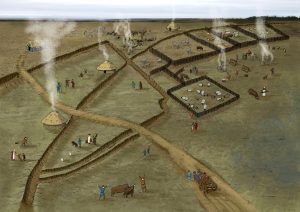The Archaeological Written Schemes of Investigation (WSI) set out the requirements for further archaeological investigation, monitoring and recording during the main construction phase. This consists of a combination of:
- - Archaeological excavation in specific locations either in advance of construction or during the initial soil and subsoil stripping;
- - Provision of archaeologists to monitor works on site; and
- - Re-instatement of any historic landscape features (for example ridge and furrow) following construction.
Triton Knoll Offshore Wind Farm, through our contractors J Murphy & Sons Ltd. and Siemens, have commissioned Allen Archaeology and Headland Archaeology to carry out the comprehensive programme of surveys and detailed archaeological excavations required. Among the many discoveries have been ancient skeletons, a Bronze Age axe head, Roman pottery, ancient farming tools, pieces of a musical instruments, and some mysterious clay balls!
Once uncovered, all finds are removed to the Allen Archaeology or Headland Archaeology offices and carefully cleaned ready for study by specialists to help tell the story of the sites that have been found. Following detailed analysis, the information will then be published and archived at The Collection in Lincoln where all archaeological works undertaken in the county are stored.
In the interim, the project has taken its findings out ‘on the road’, with a series of archaeological open days set up for Triton Knoll by its construction contractors Siemens and J Murphy & Sons Ltd. The events were held at Boston, Frithville and Burgh le Marsh, and were attended by over 300 local people, ranging from two to 92 years. The sessions were supported by archaeological experts and included scores of hands on findings, 3D models of how some parts of the region looked during Roman times, interactive games focused on ancient and modern medicines.
To see a short film of the archaeology open day at Frithville and Westville Village Hall, please click here
Please click here to view our Archaeology leaflet of the information displayed at the events run by J Murphy & Sons Ltd., which provides lots more information about the process carried out and what has been found. To view the high resolution Archaeology Exhibition Boards, click here.
DISCOVERY SPOTLIGHT – BICKER FEN
An area of six hectares has been investigated at Bicker Fen by Allen Archaeology on behalf of Siemens, with exciting evidence of the late Iron Age through to mid-late Roman farming landscape.
Multiple enclosures, known as ladder settlements were found, which were attached to a double ditched trackway. Storage structures and several ring gullies as well as evidence of round houses were located.
An area of industrial activity, possibly related to salt-making, once a major industry in the Fens, was also unearthed. And, a large, multiple layered deposit of burnt material, probably rubbish being dumped from the nearby settlement was also evident.
In addition, large quantities of Roman pottery were unearthed. Some of the finds were decorated and stamped red pottery, known as Samian Ware, indicating the local people were of a relatively high status. Amongst the finds are a piece from a musical instrument and a bone awl - a long, pointed spike generally used for piercing or marking materials such as leather.
The reconstruction, below, shows how the area may have looked. Click on the image to view a more detailed, higher resolution version.

